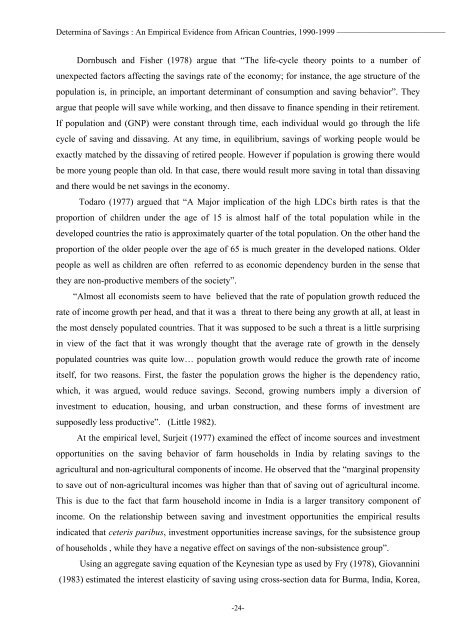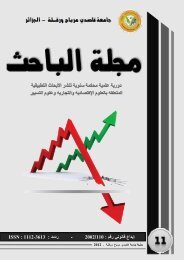El-BAHITH REVIEW Number 09 _ University Of Ouargla Algeria
Annual refereed journal of applied reserch in economic, commercial and managment sciences
Annual refereed journal of applied reserch in economic, commercial and managment sciences
You also want an ePaper? Increase the reach of your titles
YUMPU automatically turns print PDFs into web optimized ePapers that Google loves.
Determina of Savings : An Empirical Evidence from African Countries, 1990-1999<br />
____________________________________________<br />
Dornbusch and Fisher (1978) argue that “The life-cycle theory points to a number of<br />
unexpected factors affecting the savings rate of the economy; for instance, the age structure of the<br />
population is, in principle, an important determinant of consumption and saving behavior”. They<br />
argue that people will save while working, and then dissave to finance spending in their retirement.<br />
If population and (GNP) were constant through time, each individual would go through the life<br />
cycle of saving and dissaving. At any time, in equilibrium, savings of working people would be<br />
exactly matched by the dissaving of retired people. However if population is growing there would<br />
be more young people than old. In that case, there would result more saving in total than dissaving<br />
and there would be net savings in the economy.<br />
Todaro (1977) argued that “A Major implication of the high LDCs birth rates is that the<br />
proportion of children under the age of 15 is almost half of the total population while in the<br />
developed countries the ratio is approximately quarter of the total population. On the other hand the<br />
proportion of the older people over the age of 65 is much greater in the developed nations. Older<br />
people as well as children are often referred to as economic dependency burden in the sense that<br />
they are non-productive members of the society”.<br />
“Almost all economists seem to have believed that the rate of population growth reduced the<br />
rate of income growth per head, and that it was a threat to there being any growth at all, at least in<br />
the most densely populated countries. That it was supposed to be such a threat is a little surprising<br />
in view of the fact that it was wrongly thought that the average rate of growth in the densely<br />
populated countries was quite low… population growth would reduce the growth rate of income<br />
itself, for two reasons. First, the faster the population grows the higher is the dependency ratio,<br />
which, it was argued, would reduce savings. Second, growing numbers imply a diversion of<br />
investment to education, housing, and urban construction, and these forms of investment are<br />
supposedly less productive”. (Little 1982).<br />
At the empirical level, Surjeit (1977) examined the effect of income sources and investment<br />
opportunities on the saving behavior of farm households in India by relating savings to the<br />
agricultural and non-agricultural components of income. He observed that the “marginal propensity<br />
to save out of non-agricultural incomes was higher than that of saving out of agricultural income.<br />
This is due to the fact that farm household income in India is a larger transitory component of<br />
income. On the relationship between saving and investment opportunities the empirical results<br />
indicated that ceteris paribus, investment opportunities increase savings, for the subsistence group<br />
of households , while they have a negative effect on savings of the non-subsistence group”.<br />
Using an aggregate saving equation of the Keynesian type as used by Fry (1978), Giovannini<br />
(1983) estimated the interest elasticity of saving using cross-section data for Burma, India, Korea,<br />
-24-















